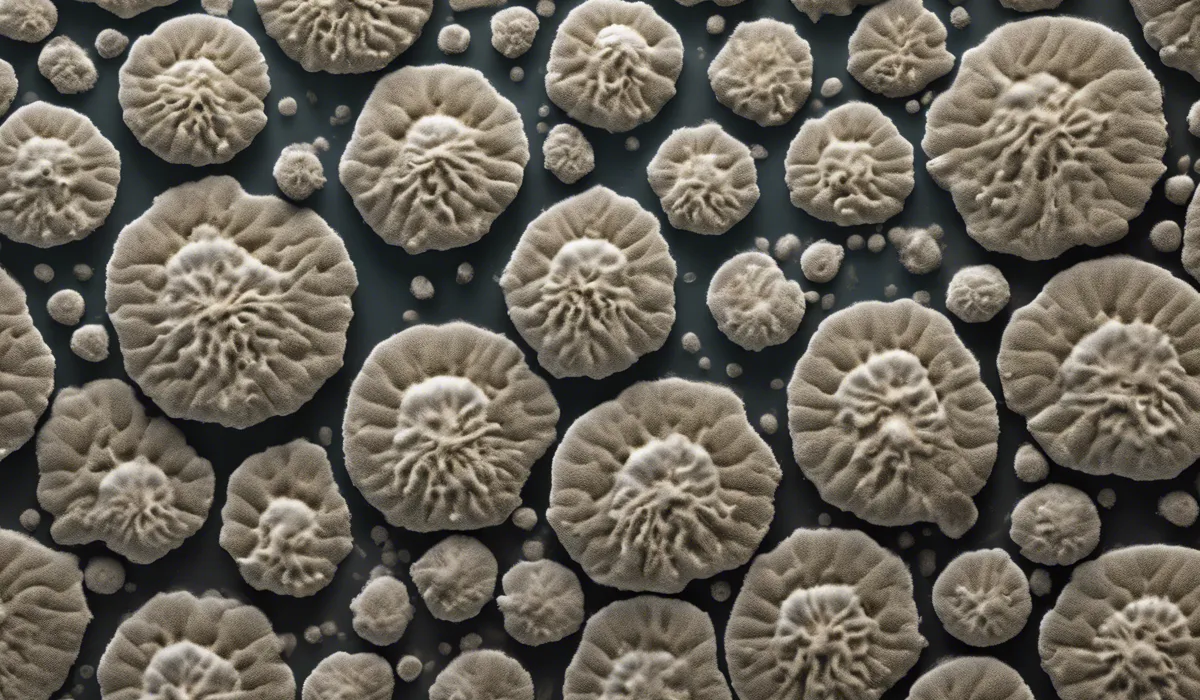Mold spores are microscopic, airborne reproductive particles of mold fungi. They can be found both indoors and outdoors, spreading easily through air, water, or on animals. Mold spores thrive in moist environments, leading to growth and potential allergen exposure.
Understanding Mold Spores

Definition and Basic Characteristics
Mold spores are tiny, lightweight particles that molds produce to reproduce. These spores are so small that they can float through the air and are not visible to the naked eye.
Mold spores are hardy and can survive harsh conditions that the mold itself may not withstand. They become active and start to grow only when they land on moist surfaces.
This ability to remain dormant and then spring to life under the right conditions makes mold spores a persistent part of our environment.
Comparison to Plant Seeds
Similar to how plants use seeds to reproduce, molds use spores. However, mold spores are much simpler than plant seeds and do not require soil to grow.
They can attach to various surfaces, especially those that are damp and rich in nutrients. Once the environment is right, mold spores can germinate and form new mold colonies, spreading quickly in the right conditions.
Role in Reproduction
Mold spores play the essential role of ensuring the survival of the mold species. Each spore has the potential to become a new mold colony.
When conditions are not favorable for growth, the spores can wait for long periods, sometimes years, until they encounter the perfect environment to start the mold life cycle anew.
Ubiquity of Mold Spores
Mold spores are virtually everywhere, both indoors and outdoors. They can easily enter homes through windows, doors, or on clothing and pets.
In the outdoor environment, mold spores play a crucial role in breaking down organic matter, but indoors, they can become a nuisance and a health hazard.
How Mold Spores Affect Health and Environment?

Potential Health Risks
Inhaling mold spores can pose health risks, particularly for people with allergies, asthma, or weakened immune systems.
Exposure to mold spores can lead to a variety of symptoms, including coughing, sneezing, and itchy eyes.
In some cases, it can cause more severe reactions like shortness of breath or even lead to infections in the lungs.
Allergic Reactions and Respiratory Issues
Many people are allergic to mold spores. When they inhale these spores, their immune system overreacts, causing symptoms such as runny nose, skin rashes, and asthma attacks.
These allergic reactions can range from mild to severe and can significantly impact a person’s quality of life.
Impact on Indoor Air Quality
Mold spores contribute to poor indoor air quality, which can affect everyone, not just those with allergies or asthma.
Breathing in mold spores can lead to a general feeling of unwellness, and over time, can contribute to the development of more serious health issues.
Effect on Building Integrity
When mold spores settle on damp areas in a building, they can start to grow and spread. This growth can damage various materials, including wood, ceiling tiles, and insulation, leading to structural issues and costly repairs.
Role in Ecosystem
In nature, mold spores are essential for the decomposition of organic materials, returning nutrients to the soil and supporting the ecosystem.
They help break down leaves, wood, and other organic matter, which is a crucial process in natural environments.
Prevention and Control of Mold Spore Proliferation

Controlling Moisture and Humidity
Keeping indoor spaces dry and well-ventilated is key to preventing mold growth. Use dehumidifiers and air conditioners to maintain a low humidity level, ideally between 30-50%.
Fix leaks and dry wet areas promptly to deprive mold spores of the moisture they need to grow.
Cleaning and Maintenance Practices
Regular cleaning can help control mold spore levels in your home. Vacuum and dust often, and use mold-killing products in bathrooms and other areas prone to moisture.
Keep your home well-maintained to prevent conditions that favor mold growth.
When to Seek Professional Remediation?
If you find large areas of mold or experience water damage, it may be time to call in professionals.
Mold remediation experts can safely and effectively remove mold from your home, ensuring that it won’t pose a health risk to you or your family.
Importance of Ventilation and Filtration
Good ventilation helps reduce moisture and the spread of mold spores. Use exhaust fans in bathrooms and kitchens, and consider an air purifier with a HEPA filter to capture airborne spores.
Ensuring that your living environment has clean air can significantly reduce the risk of mold-related health issues.
FAQs About Mold Spores
What exactly are mold spores?
Mold spores are tiny, seed-like particles produced by mold fungi that can be transported through the air, water, or by animals, serving as a means of reproduction for the mold.
Where can mold spores be found?
Mold spores are ubiquitous and can be found in both indoor and outdoor environments, with a higher concentration in damp or moist areas.
How do mold spores spread?
Mold spores spread easily through the air and can also be transported by water currents or on the fur and skin of animals.
What conditions are ideal for mold spore growth?
Mold spores grow best in moist, warm environments with a food source such as wood, drywall, or other organic materials.
Are mold spores harmful to human health?
While not all mold spores are harmful, some can cause allergic reactions, respiratory issues, and other health problems, particularly in sensitive individuals or when present in large quantities.
Final Thoughts
Mold spores are the tiny reproductive units of mold fungi, omnipresent in both indoor and outdoor environments.
These spores disperse with remarkable ease via air, water, or animals, and when they land in damp areas, they multiply, potentially causing mold growth and increasing the risk of allergen exposure for individuals.
